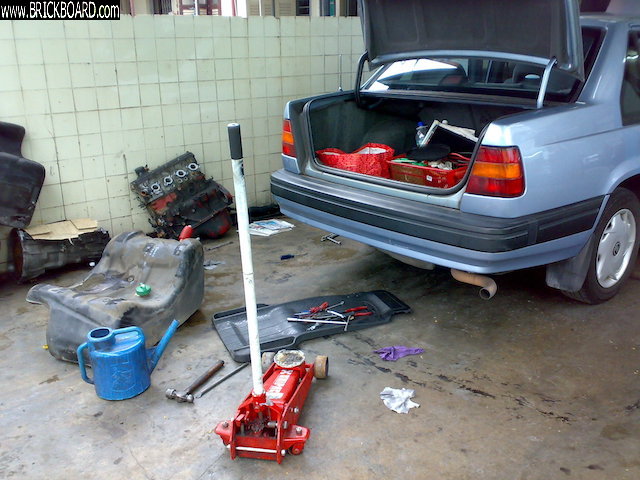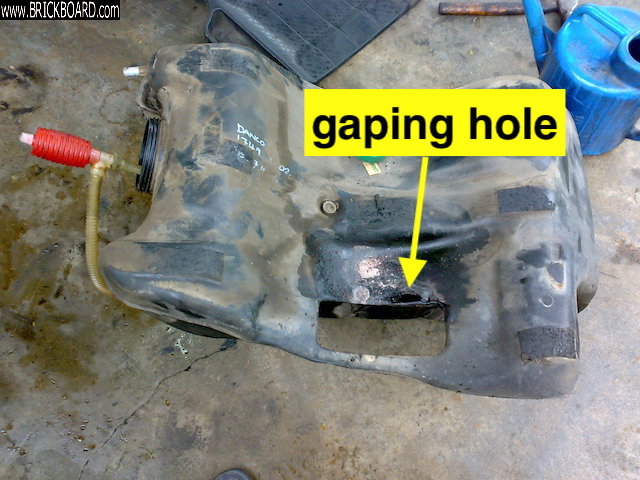|
|
|
Ive never been able to get much mpg,,now itas aroun 11 & I repolaced or tuned up everythhing,,,
|
|
-
|
|
|
Hi,
Do you have a locking gas cap ?
At the time and place that I was in high school it was very rare that any student owned a car. One kid I knew had one and after getting caught siphoning gas, told me that his MO was to gauge the tank depth with his siphon tube and never take more than a gallon or two from each car. There were about 40 cars in our neighborhood, including my father's, that he cycled through.
He worked at night and got away for a couple of years with nobody wise to it. Eventually somebody spotted him in the act.
Peter
|
|
-
|
|
|
& my latop sucks,,never buy a lenovo
|
|
-
-
|
|
|
Hi,
Depending on where it's leaking, you could probably weld it. I know the stuff they use on 5 gallon plastic jugs is easy to weld.
Peter
|
|
-
|
|
|
weld??On a plastic tank??
|
|
-
|
|
|
I've welded, or had welded a couple of white water kayaks...which take more hits than a gas tank.
However, with a plastic tank, you only need an Epoxy that can withstand petro fumes. No heat required. Just the right epoxy....there's no 'pressure' in a gas tank, unlike a radiator.
eg: actual 'welding'
https://floatingkayaks.com/kayak-plastic-welding/
|
|
-
|
|
|
Dear CeeBee1,
Hope you're well. You're 100% right that the correct epoxy must be used.
To ensure the epoxy can bond to the plastic, the surfaces around the puncture must be surgically clean. Gasoline contains paraffins - waxes - that will prevent the epoxy from bonding. These paraffins coat the inside of the tank.
So, the tank wall surfaces around the puncture need to be wiped with acetone or its chemical cousin, methyl ethyl ketone (MEK). These solvents will remove any trace of any contaminant. Both of these solvents are very flammable and should not be inhaled. So, the cleaning should be done in well-ventilated area. Outdoors is best.
If the puncture area can be reaches from the inside of the tank - the fuel send unit opening is about 4" in diameter - then the tank wall surfaces around the puncture should be wiped with solvent. If there's no access to the puncture area, this area may be cleaned by spraying solvent through the puncture opening or by using a pipe cleaner dripping with solvent, bent at a 90° angle.
Once gasoline residues have been removed from around the puncture area, the surfaces should be roughened with coarse sandpaper and all dust removed using the same solvent.
The epoxy should then be applied and allowed to cure.
As you correctly note, the gas tank is not under pressure. It is also not subject to impacts. Thus, if the surfaces around the puncture are properly cleaned, an epoxy patch should be very durable.
Hope this helps.
Yours faithfully,
Spook
|
|
-

|
|
Yes, even though the word "welding" is usually associated with metals, with the right equipment, plastics can be welded too.
|
|
-
|
|
|
Dear Blindboy,
Hope you're well. A fuel tank is Volvo #3507456, The cost is about $1,250 at a U.S.-based Volvo dealer.
Hope this helps.
Yours faithfully,
Spook
|
|
-
|
|
|
Don’t throw parts at the problem. Confirm the tank is leaking first. That’s not a job you want to do unless absolutely necessary….😊
--
Will I buy another Volvo??? We'll see....
|
|
-
|
|
|
Have you done a thorough visual search of the tank? I mean everywhere. Is the tank rusted? It is, after all, almost 30 years old. Did you look at the seams? My old 1973 BMW 2002 tank rusted out at the seam. Fill the tank, drive it and check everything right away. Remember gas evaporates very quickly….
--
Will I buy another Volvo??? We'll see....
|
|
-
|
|
|
Dear jwalker,
Hope you're well. The fuel tanks in 940s (at least from 1993 onwards) are made entirely of plastic. It is, of course, possible for a seam to split. But corrosion does not affect plastics.
Hope this helps.
Yours faithfully,
Spook
|
|
-
|
|
|
Yes in 2008. Strong gas smell at parking lot. Replaced the entire tank. No fuel spill though as I seldom fill the tank full unless for long journeys.


Check (don't just replace them) the front end items too. Conical (flying saucer) bushings, inner & outer tie rods, lower arm ball joint and lastly front tire alignment
Amarin
|
|
-
|
|
|
Dear Amarin,
Hope you're well and stay so. I infer that the tank had served well for about 15 years: a manufacturing defect was not a likely cause. The tank's walls are abut 6 mm (1/4") thick, so pretty puncture-resistant.
What likely caused the hole? Road hazard? Mechanic's error? Failure of an adjacent part?
Thanks for the benefit of your insights!
Stay well!!
Yours faithfully,
Spook
|
|
-
|
|
|
Dear Spook,
I think it was probably due to mechanical stress, the way the tank was mounted in the car with that curved upper part of it resting against the body. It possible also that some careless mechanic used the bottom part of the tank to hoist the car. In those days I would just send the car in and gone home, without waiting to see the work process.
Amarin
|
|
-
|
|
|
I'll buy your theory of a mechanic catching part of the tank with a misplaced jack. He may or may not have been trying to support the tank. Dropping the tank is occasionally done when trying to get to the sending unit to replace the fuel pump by those not familiar with the access hatch. The saddles of some jacks and lifts have a four segment lip. One of those segments would fit perfectly in that puncture hole.
--
Dave -still with 940's, prev 740/240/140/120 You'd think I'd have learned by now
|
|
|
|
|


